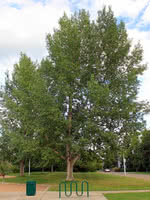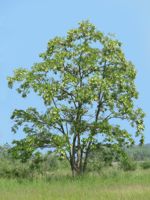Mon-Fri 9am - 5pm Mountain time
Assiniboine Poplar vs Black Locust
Populus x Assiniboine
Robinia pseudoacacia
Assiniboine poplar is a tall, fast growing tree that has a shapely oval form and dense foliage. This hybrid poplar is a male clone and produces no fuzz or fluff. Assiniboine poplar can handle tough conditions such as: urban pollution, environmental salt, drought, poor soil, and even some standing water.
Black Locust is an attractive tree. Its distinctive leaves are made of about a dozen bright green leaflets. It also notable for its fragrant white flowers, which smell of citrus.
Black Locust can grow in many situations, but prefers dry areas with lots of sun. It is robust and is an excellent choice for establishing shade in dry, open areas.
Important note: Much of the Black Locust is toxic to humans and livestock, including seeds, bark, and leaves.
Assiniboine Poplar Quick Facts
Black Locust Quick Facts
In row spacing: 2.4 - 3 m (8 - 10 ft)

